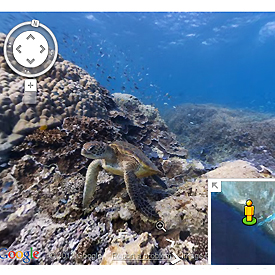Hold the phone, or hold the scuba gear because Google street view has gone where streets can’t go. It was at the 2012 BLUE Ocean Film Festival that Google introduced its new Ocean View feature that will be more than just a cool way to see what’s happening under the sea.
The Google Ocean View system will be able to monitor many of the world’s reefs, allowing scientists to see how they are adapting to environmental changes. The ocean images were made possible by the meticulous efforts of divers from Catlin Seaview Survey. Using thousands of 360-degree panoramic images, these stunning maps have been created by stitching them together.
Six different reefs were photographed, from Australia to the Philippines, and Hawaii. Each one will be studied closely over many years. This is just the beginning as these reefs will be revisited and more will be added through the use of divers and robots. Future places to be explored include Bermuda, the Caribbean, and other sites where reefs will be studied.
Through Google’s Ocean View you’ll feel as though you’re walking on the ocean floor, moving along in a surreal world of beauty and mystery. Along the way you’ll see many ocean creatures like turtles, eels, and schools of brightly-colored fish. The amazing images were captured by the SVII camera, the world’s first underwater camera that can be operated remotely by a tablet.
Approximately 71% of the earth is covered by ocean waters, so there is an endless world to explore. Already Google, in partnership with the Catlin Seaview Survey, has collected an impressive number of images that can be viewed by the public.
Google’s new Ocean View project goes beyond exploration, scientific study, and just showing the public cool pictures. It is a project geared to raise awareness of our often fragile ecosystem and how it affects all life. These coral reefs suffer deterioration and destruction due to man-made pollutants and carelessness. Coral reefs have many functions including providing a much-needed habitat for many of the oceans’ great creatures.
Google plans on going even deeper to capture images by using digital single-lens reflex cameras attached to remote-controlled vehicles. These vehicles will be able to go down to a depth of 30 to 100 meters. Many reefs viewed from above 30 meters are literally just the tip of the iceberg.
With more than 15,000 images already created, Google will be sharing only the best with the public. However, even the least appealing images can hold a wealth of information for scientists to study. Therefore, every image can potentially be invaluable and will be available for scientific purposes. Tens of thousands will be produced over the next year.
The ocean is vast and our desire and need to better understand it will lead to greater exploration and study. This is just the beginning of what might well become one of the greatest achievements of underwater exploration in the years to come. Our planet and our very lives are counting on it.
Image Examples
See a sea turtle swimming in Great Barrier Reef




